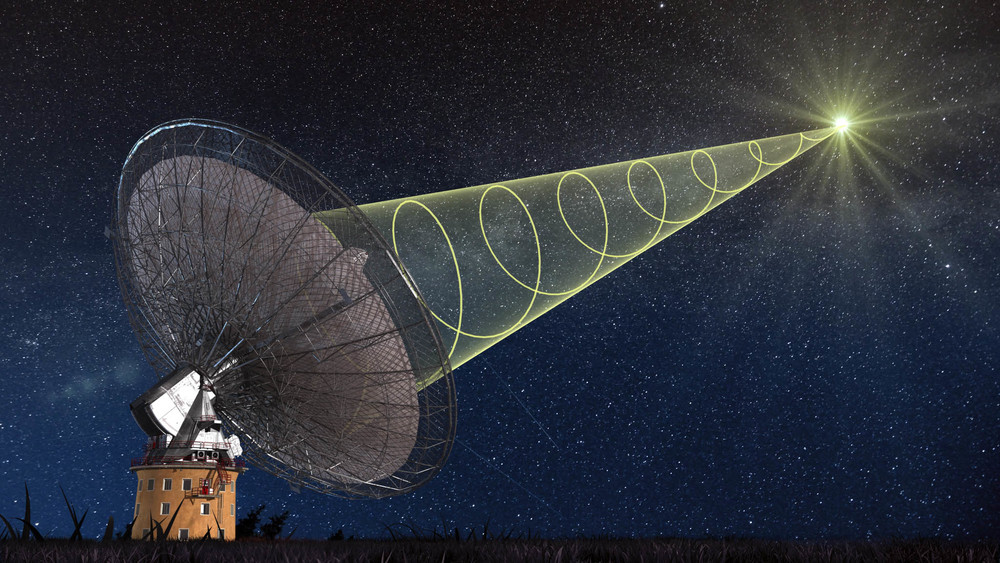Fast radio bursts are split-second intergalactic blips of radio waves we’ve detected over the last decade. You’d think that if we pointed our telescopes and other space cameras in the direction these bursts came from, we’d spot something else, too. But to date, we’ve got nothing—just radio waves.
Scientists spotted the newest burst (and the 22nd ever), FRB 150215, on February 15, 2015 with the Parkes Telescope in Australia. FRB 150215 was strange for lots of reasons—based on the direction in the sky it came from, we probably shouldn’t have been able to see it. But despite what may have been the most well-coordinated follow-up effort yet with all sorts of equipment, scientists still don’t know the cause of it, or similar FRBs spotted on different occasions. That’s exciting, scary and frustrating.
“We spent a lot of time with a lot of telescopes to find anything associated with it. We got new wavelength windows we’ve never gotten before. We looked for high-energy gamma rays and neutrinos...we ruled out some source classes but no detection is a little unhelpful. We’re still trying to figure out where this one came from.” the study’s first author, Emily Petroff from the Netherlands Institute for Radio Astronomy, told Gizmodo.
Since the first FRB discovery in 2007, we’ve gleaned shockingly little about these mysterious radio sources. We know they’re from far away, probably outside the galaxy. We know one of them repeats. We know that there are more theories about what they might be than actual observations. And that’s sort of it.
FRB 150215 has definitely added more data and more mystery. The scientists had to look through the Milky Way galaxy to spot it, and the galaxy’s magnetic field should have changed the way the radio burst’s light traveled—but it didn’t.
“It probably traveled through some kind of hole in the Milky Way that makes it easy to find compared to normal searches in the galaxy,” said Petroff.
In other words, this probably says more about the Milky Way than about FRB 150215. She and her team posted their observation on the arXiv preprint server yesterday, and you can read her thread about it here.
But not finding any corresponding signal during subsequent searchers is frustrating, and this follow-up effort was one of the most well-coordinated yet. After finding the first repeating FRB signal, FRB 121102, scientists are hungry to discover any other hints to better identify what these bursts might be or where they’re coming from.
“I have to say this is a fantastic paper but it is a bummer of a paper. They threw every resource that we have at this FRB. They followed up with TNT,ANTARES,The Australian Telescope,Swift,Chandra,Magellan, the Dark Energy Camera, GMRT, Lovell, the VLA, and they see nothing. It is incredibly important in the sense that even with relatively prompt follow up there isn’t an afterglow or counterpart that is obvious. It’s not very often in science that you get to work on something that’s so brand new and so unknown that you get to answer the fundamental questions.” Shami Chatterjee, senior research associate at the Cornell Center for Astrophysics and Planetary Science told Gizmodo.
These FRBs leave no trace, be they x-rays or visible light, neutrinos or anything else. These researchers have essentially heard a noise (in this case the radio waves, which are actually light waves), turned around to see what made the noise, and have seen nothing in 22 different places. This time they turned around with almost every flashlight, searchlight, Geiger counter, whatever they had, and still saw nothing. And the Parkes telescope can localize the signal to a patch of sky, but not one small enough to give a specific galaxy source like the Very Large Array was able to do.
If you were in your house you’d probably say ghosts—or aliens. But Petroff pointed me toward her Twitter thread explaining how advanced alien civilizations probably weren’t the cause. Andrew Siemion, Director from the Berkeley SETI Research Center, told Gizmodo that he’s holding out for the possibility of a link between FRBs and extraterrestrial life, but agreed more data will likely continue to rule out whatever hypotheses we might have towards these sources’ origin.
One researcher, Harvard astronomer Peter Williams, told Gizmodo he was skeptical FRBs would even come with another signal—but he too just wants to see more of them. And Harvard Astronomer, Edo Berger, who published his own paper on FRBs yesterday, told Gizmodo that follow-up observations after a signal is first detected aren’t well motivated. He thinks the radio waves originate many years after a supernova or gamma ray burst has occurred, and the remnants have settled into a magnetic neutron star. That means spotting the source of an FRB might require spotting a gamma ray burst or exotic explosion first, then looking for the radio waves decades later, not the other way around like we’re doing now.
At the current estimates, there should be thousands of FRBs happening daily across the sky. Several new telescopes should be able to confirm that soon, so that rather than make a big deal about every new FRB, we can start talking about trends, and similarities or differences between the signals.
Petroff, who’s discovered several FRBs at this point, is honestly just happy to be here.
“It’s not very often in science that you get to work on something that’s so brand new and so unknown that you get to answer the fundamental questions. It’s exciting to be in these very early stages of the field when you can make a big impact with your research and answer these really big questions.” she said.
[arXiv]

